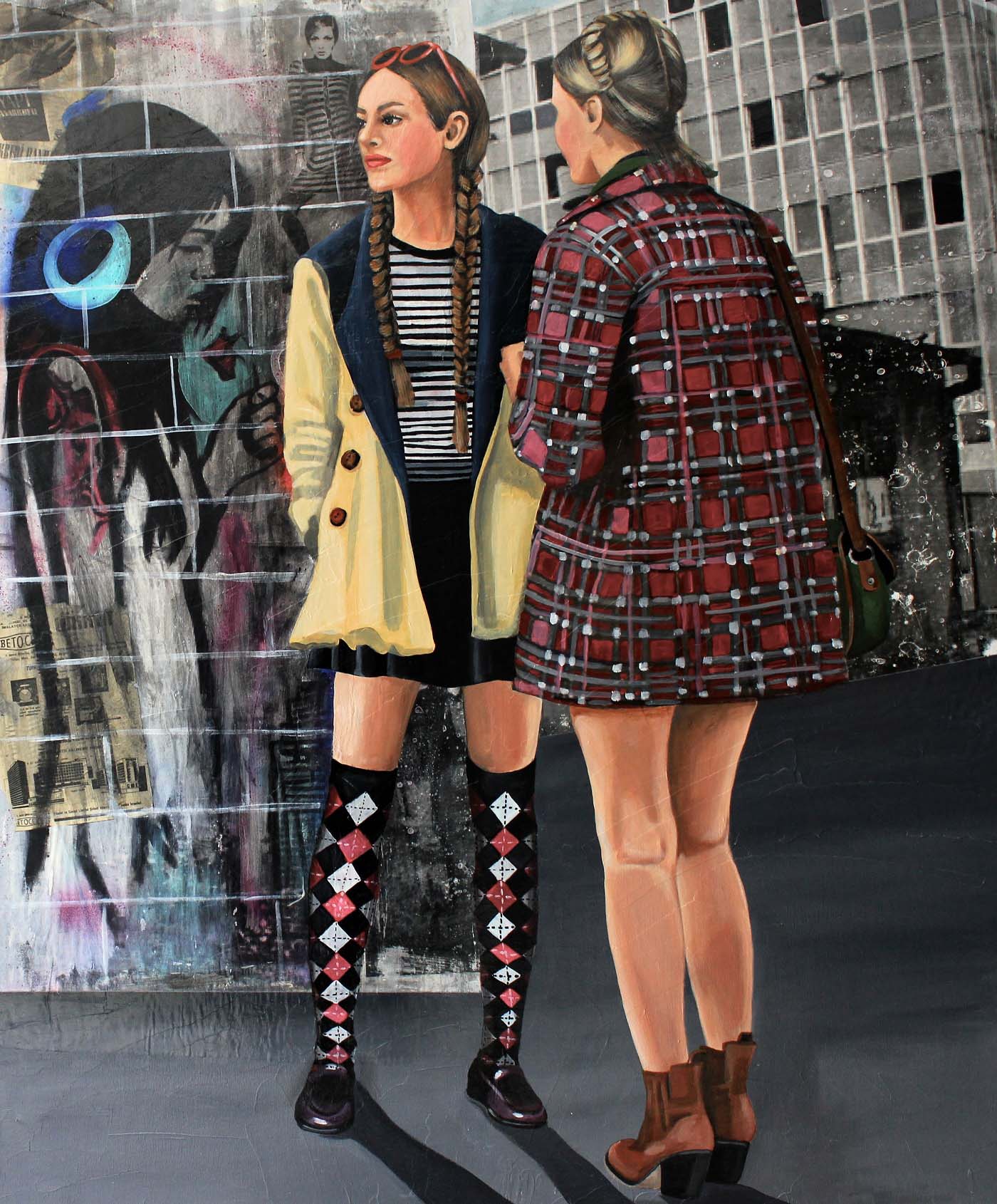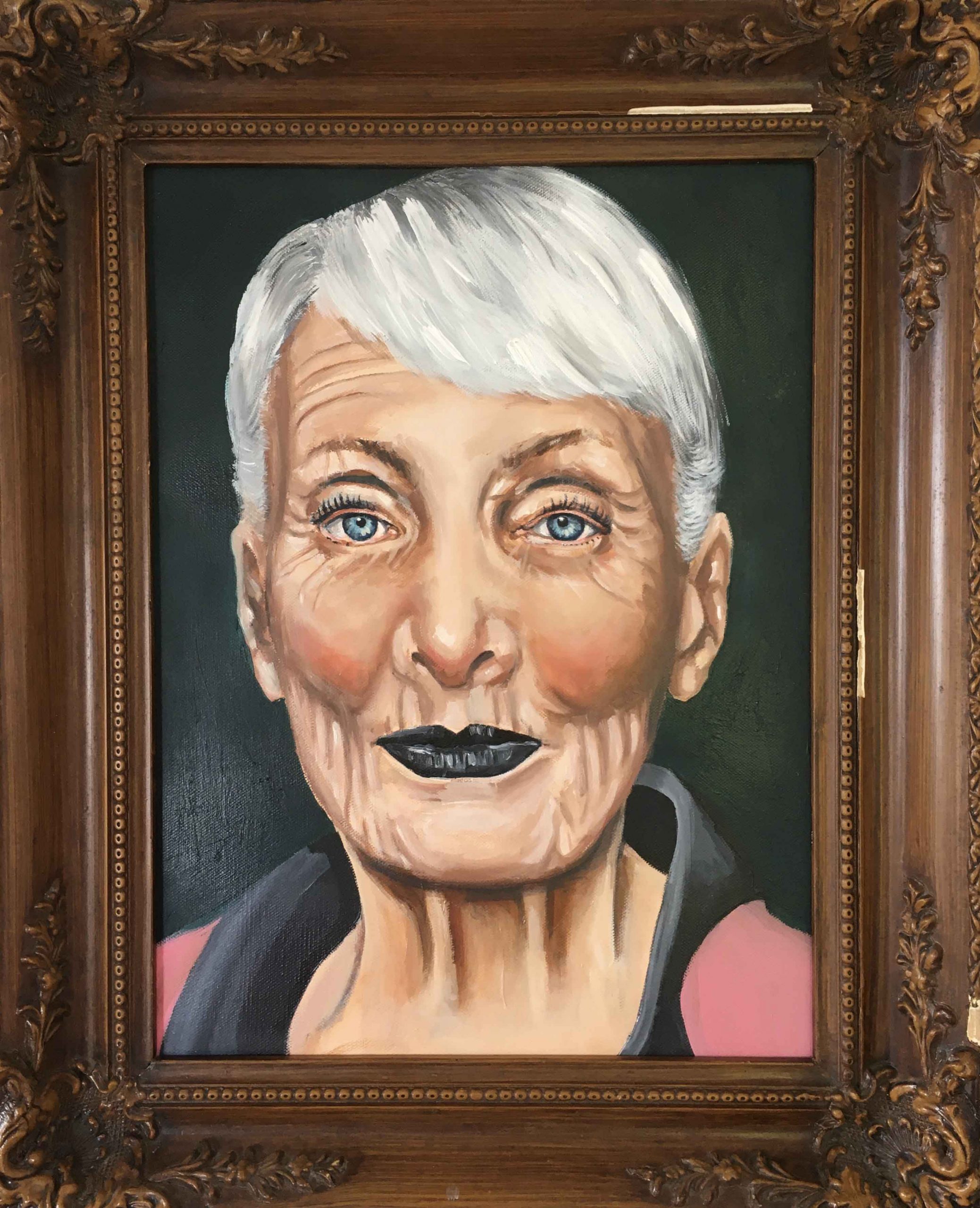In her paintings, Mihriban Mirap focuses on the consumption culture by representing people living in urban places as well as examining the notion of beauty defined in society by depicting the aged women. She opposes the norms imposed in a critical attitude. We had a brief conversation with the artist on her painting adventure, and on her recent series of works in which she focuses on the concept of ‘eternal beauty’.
Mihriban, completed her undergraduate and graduate degrees at Yeditepe University, Faculty of Fine Arts, at the Department of Plastic Arts. She lives in Istanbul and besides painting, she works as an art teacher in various institutions.
There are two different series of your paintings represented on art50.net. One of the series focus on urban life while the other series focus on the concept of ‘beauty’. Could you briefly explain the development of these two series?
First of all, I would like to talk about the first of these two, because these series are successive and support each other. The topics that I focus on in my first series were the norms of life that today’s mass culture offers to people. Urban life, people living in urban areas, the chaos of the city, the concept of speed raised by the city life, the perception of modern life, as well as the consumption culture, construct the main axes of my paintings. With the developments in the industry and the rise in consumption every day, becoming a dependent person on the norms and technology raised in the cities is a theme that I focus on. Today, what we wear, the goods, our accessories within technology become the most important parts of our self-presentation in public spaces and social media. I examine our dependence on brands and icons of popular culture. Therefore, I depict young individuals who are the most active consumers of mass culture. In the other series of aged women, I depict the portraits opposing the concept of “eternal beauty” that mass culture imposes on people. Today, the culture industry (televisions, newspapers, advertisements) promises people endless youth and beauty. Botox, facelift, silicone, creams for wrinkles, hair dye, etc. All of these commitments given by the mass media and consumer society makes us look like only one type. I do represent the portraits of aged women as opposed to the images of a single stereotype presented by the mass media and criticize the desire to be beautiful.

The paintings in which you focus on the consumption culture were quite before in terms of time. Do you still work on these artworks? Do you take your subjects of urban cities from your observations, or do you choose to bring together the images from popular culture?
In my previous series, I was examining the lifestyles of individuals within the city which is based on consumption. From time to time, I go back to these artworks because it is inevitable for me to contribute to that culture as a painter who lives in it in the 20th-century urban life and is one of the consumers of mass culture. In my paintings on urban life, I create collages by combining photographs that I took and/or use images from social media that present the urban and consumerism used in advertisements in the past but still remembered today. While working on the collage technique on canvas, I use an allegorical style to strengthen the language of my expression. I try to represent the fact that the old and the new are shifting each other, especially the new is trying to reveal itself as a dominant figure. In my paintings, concepts such as the city, individualization, fashion, mass culture, popular culture sometimes appear as silhouettes and sometimes as the main characters to draw attention to the tastes of the century we live.
Who are your models in aged women portraits in which you focus on the concept of beauty? What does beauty mean to you? Is there a specific reason to examine the concept of beauty over ‘women’?
The figures in my aged women portraits are living individuals of today. I gather and represent these figures, inspired by the photos I took, the stories I heard, the photos I found in social media, by adding my own interpretation. I cannot say that I am working only on female figures. For example, in my painting titled “Timeless Phenomenon” of 2017, I made the portrait of Günther Krabbenhöft, who is a social media phenomenon and is 85 years old. Also, I had male models of different ages like him. The point that inspires me is that these people are timeless and beautiful with their structures that could keep up with the returns of their ages. Today, I argue that aged people are beautiful without any intervention from outside, and this opposes the idea of ‘eternal beauty’ that is imposed by the mass culture. With their body language, different looks, and in outfits that do not comply with the norms, the aged figures in my paintings do not surrender and do not abandon themselves as expected. They refuse to surrender to the imposed life forms. They are aware that they are coming to an end, but they live the “exact moment”.

How and when did you start painting? You had a chance to work at the studios of many renowned artists of Turkey. How did this experience reflected in your art practice?
First of all, let me make a confession to you. When I was at primary school my sister or my mother were used to do my painting homework. I was a very lazy student. My family didn’t think that I would be anything. I was a daydreamer. But my visual memory was good though. My awareness of art initiated during high school. In our home, there were many books on artists and art history. While instinctively scanning those books, I found myself dreaming and I started copying them. I was painting not because I had a special talent, but because I loved it. I had found my way to express myself. Then I decided to study Fine Arts at the university. I was lucky in terms of my choice of university because the Department of Plastic Arts at Yeditepe University shelters many other disciplines. Besides, I took courses such as ceramics, sculpture, printing techniques, murals, and painting, I also had the opportunity to take theoretical courses such as contemporary art philosophy, art history, comparative art history. I had a chance to work in the workshops of my instructors who brought significant value to Turkish art. Of course, this experience enabled me to recognize different disciplines and reflect them to my art.
Who are the artists that inspire you? If you were given an unlimited budget with which you can buy anything you want, what would you buy and why?
First of all, there are renowned masters and young artists in Turkish art that I admire. It won’t end if I start to count my inspirations, but I would like to use my budget for Alex Katz’s paintings. In his paintings, the way that Alex Katz depicts dull figures in seductive but emotionally disconnected settings with a quite simple language impresses me a lot.
Is there a specific method or any stimulus that you use to trigger your creativity? Can you explain your daily routine?
Many factors trigger me. A movie I watch, a book I read, a piece of music I listen to, or a slice from the life that I witness anywhere, triggers me. Usually, my day starts by getting up late. I want to go to my workshop because it is good for me to be there even if I don’t paint. I generally like to listen to audiobooks when I paint. Some books that I listen to can even inspire me. Lastly, I listened to the book of Ayşe Kulin, who is about the life of Füreya Koral. Besides the life of Koral told in the book, the life of Aliye Berger influenced me very much. And I searched Aliye Berger’s life in detail. A portrait I came across in my research encouraged me to paint her. By adding my interpretation, I made a portrait called ‘Alyosha’ which was her moniker used in the art world.

Do you have any other projects that you are planning to produce in the near future?
Yes, I have material-based and subject-based projects. But let’s keep them as surprises to art50.net followers 🙂
As an artist who recently participated at art50.net, how did you get acquainted with art50.net? What are your expectations of taking part in one of Turkey’s leading art platforms?
To be honest, I was against the online art gallery system. I was approaching biasedly. But with the suggestion of my friends, whom I love and trust, I had the opportunity to get to know art50.net. I searched, art50.net is not just a sales-oriented platform. More than that, it is an art and artist oriented platform that emphasizes arts and culture. The common attitude with my ideas and opinions, and the way they represent the artists have changed my perspective. I hope to take part in fruitful projects together… thanks a lot to the art50.net team.
Click for the artist page.
Interview: Sena Arcak Bağcılar

